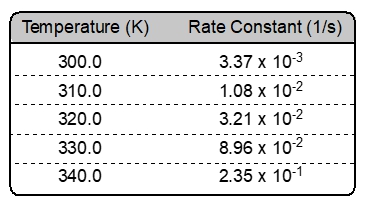A chemical reaction has rate constants of 4.6 * 10-2 seconds-1 and 8.1 * 10-2 seconds-1 at 0°C and 20°C respectively. What is the value of the activation energy? All right, so they're giving us two rate constants since this one is stated first. This is K1, and this would have to be K2 respectively. Would mean that 0°C is connected to K1 and therefore would be T1 and the second temperature will be connected to K2 and therefore it is T2.
Now we'd say here that ln(K2/K1) = -EA/R * (1/T2 - 1/T1). Here we're going to place the numbers that we have so it's ln(K2/K1). So K2 is 8.1 * 10-2 / 4.6 * 10-2. We're looking for activation energy, so EA is what we need to find. R here is our gas constant, which is 8.314 Joules/(mole·K). We're going to say 1/T2. So remember we have to add 273.15 to each one of these Kelvin temperatures. So when we do that, this becomes 293.15 K - 1/273.15 K.
Here we're going to do ln(K2/K1). When we do that, we're going to get as our answer, 0.565808. All right, so EA is going to be multiplying by what's in here. So when we do that, we're going to get a negative value in here. So this is going to be what's in here is equal to -2.49769 * 10-4. A negative times a negative gives me a positive that be positive EA times 2.49769 * 10-4 divided by still 8.314.
Here we're going to multiply both sides by 8.314, so when we do that, we're going to get 4.70413 equals EA, still times 2.49769 * 10-4. Divide both sides now by 2.49769 * 10-4. So when we do that, we're going to get our EA, which I'm going to write over here. So EA here equals 18,833.91 joules per mole.
Now if we go back up here, this has two sig figs, 2 sig figs for 4.6 and 8.1. Let's not worry about the temperatures, so let's just do this in terms of two sig figs. So that will become 1.9 * 104 joules per mole. So this would be our value for our activation energy, abbreviated as EA.


